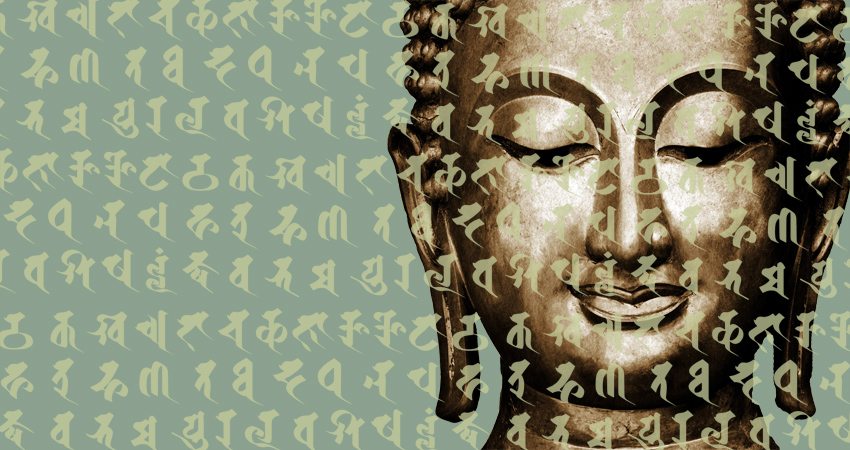When Buddhism first began in India, its adherents passed along its teachings orally. Eventually, scribes recorded them in Pali and Sanskrit, and when travelers brought the faith to China by means of the Silk Road, the Chinese translated texts and copied sutras. John Stevens wrote the following in his book Sacred Calligraphy of the East:
As soon as translations appeared the virtue of sutra copying as a devotional practice was recognized—sutra copying combined worship, literature, and calligraphy. Beginning with Emperor Daowu in 386, a long line of rulers issued imperial commands for special copying of all available sutras, and several copied portions themselves. All of the eminent monks of the period encouraged their followers to write out the sutras on which their teaching was based. For example, Zhikai (538–597), founder of the Tiantai school, instructed his disciples to copy the Lotus Sutra while Shandao (613–681), first patriarch of the Pure Land sect, made more than ten thousand copies of the Sukhavativyuha Sutra (Amidakyo). Sutras were engraved on the sides of mountains, inside cave temples, and on large sutra pillars that were erected at crossroads. Copies were made in gold and silver ink on the finest paper, enclosed in lacquer boxes, and stored in special buildings.
Holy texts also contain support for the practice of sutra copying. The Lotus Sutra contains this sentence: “After the passing away of the World-Honored One we will go to all corners of the universe, unceasingly encouraging all beings to copy, read, and recite his sutra.”
In time, practitioners thought that copying sutras was a spiritual exercise and a means to develop merit: divine energy that affects karma and can supposedly benefit others.
Travelers introduced this practice to Korea and Japan from China, and in Japan it became known as shakyo. It is, in and of itself, a pious exercise akin to prayer. Practitioners praise the divine letters with the eyes, while they keep their meaning and form in the heart. They use the mouth to intone the sounds of the letters, and their hands to write them. Approaching it in this manner, all of the senses are engaged in this spiritual practice, and if done correctly, one can attain Buddhahood.
Depending on the Buddhist sect and even individual temples, the methods used for shakyo differ. Some, like those found at Enryakuji on Mt. Hiei, are complicated, and they stretch on for days. Others are simple, and sometimes adherents even use a pen or pencil instead of traditional brushes. Visitors can see such methods at Todaiji in Nara among other places. No matter how formal the ritual is that surrounds the act of sutra copying, it is a meditative and spiritual exercise. Therefore, practitioners treat it as such.
A bit of preparation is needed, and the forthcoming preparatory techniques can be applied to other types of artwork, including poetry, woodcarving, ceramics, painting, and many others.
First, get your paper, brushes, and ink ready for the shakyo exercise. Sit for a moment where you are going to begin creating. Make sure that you do not hunch your shoulders forward, and keep your back straight. Be completely relaxed yet stable. Mentally feel your body. Note its center of gravity; find its center. Remain focused on the middle, and consider the breath. Feel as though your breath emanates from the center. This place is known as the tanden or hara in Japanese, and dantian in Chinese. If you train enough, it will eventually become the control center for all bodily movements. While remaining focused on this spot, feel with each breath as though you were becoming increasingly heavier, connected to the ground, but at the same time, extend energy in all directions. Feel the energy flowing from your center along your spine to your head, and feel it gushing through your arms and out your fingertips. In this way, the body is learning how to function together harmoniously.
When you feel that you have attained this, or at least a degree of it, pick up your brush and dip it into the ink. You do not want your hand to function independently; you want your entire body and mind working together melodiously. Remain concentrated, and make each stroke sharply. Put all of your intent into it. Do it with your entire body and mind, not just your hands. The grip pressure should be constant and consistent. Not too strong, light. Continue to work. Do not stop. If you make a mistake, just continue. (If you choose to, you can cross it out.) A mistake is a sign that your concentration has lapsed, but don’t worry, it will get better in the future. It becomes increasingly easier to maintain concentration for extended periods after doing drills like this. Such exercises can have a profound influence on adolescents and others who may find it difficult to concentrate. Everything is difficult at the beginning, and unless one learns how to concentrate and then practices it, it will always remain elusive. Nothing is impossible to the concentrated mind, and you must learn and perfect this attention. Shakyo is one method of attaining this great skill.
